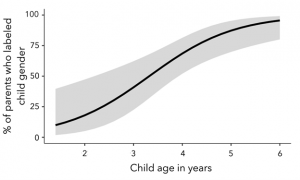Transgender parents may let children explore gender on their own before labeling a child’s identity

According to our recent research, many transgender parents with children between one-and-a-half and six years of age hesitate to label their child’s gender identity. In addition, our results suggest that many children with transgender parents play in ways that conform to gendered societal expectations, while others play in more gender-expansive ways.
Previous research has shown that misgendering, or incorrectly labeling someone’s gender identity, often harms a person’s mental and physical health. Our new research suggests that transgender parents may offer their children supportive environments to explore their own gender identity and expression.
We also found a strong link between child age and the likelihood of labeling (see Figure 1): the older the child, the more likely parents were to label their child’s gender identity. Transgender parents of elementary-school-aged children may be more likely than transgender parents of toddlers to label their child’s gender identity.

This study can’t speak to whether transgender parents assign their children gendered names or pronouns or otherwise socialize them in gendered ways. But it does suggest that transgender parents hesitate to label their child’s gender identity before their child can communicate it themselves.
Method
Based on a subsample of the Gender Diverse Parents Study, our study utilized web-based surveys of 64 nonbinary and binary transgender parents across the United States. Binary transgender people identify primarily as women, girls, men, or boys; these labels do not capture nonbinary peoples’ gender identity.
The Gender Diverse Parents Study measured children’s gender expression: their interest in masculinized and feminized toys (e.g., toolsets and jewelry), activities (e.g., climbing and playing house), and personality characteristics (e.g., enjoying tumble play and liking pretty things). Participants rated how often their child engaged with and enjoyed each item or activity. The Gender Diverse Parents Study also asked parents about the sex their child was assigned at birth and about their child’s current gender identity.
We found that 41% of the participants did not report their child’s current gender identity, choosing either “unknown,” “choose not to label,” or “self-describe,” with a text field to write in their response. For “self-describe,” parents often described a gender-fluid child or a child who had not verbalized their gender identity. Several parents wrote, “I think it’s too early to know.”
Although the surveys revealed that, on average, children’s play was conventionally gendered, there was a great deal of diversity within the sample. For example, older children of nonbinary parents may be more likely to engage in gender-expansive play (see Figure 2).

This study was published on Aug. 17 in the journal Frontiers in Psychology.
Implications
Some believe that parent gender identity has everything or nothing to do with child gender expression. But this study suggests that the truth is somewhere in between.
This recent study is one of the largest to focus on the gender of young children with transgender parents. It will further inform our understanding of gender development, parenting, and child development more broadly.
Rachel G. Riskind, PhD is a professor of Psychology at Guilford College. Dr. Riskind is a feminist social developmental psychologist focusing on parents, children, and adolescents. Her recent research describes family processes in families headed by transgender parents. You can follow her on Twitter @RachelRiskind
Dr. Samantha L. Tornello is a professor of Human Development and Family Studies at Penn State. She has three major research interests: Family, sexual orientation, and gender identity. Most of her work has focused on the role of family composition and parental sexual orientation and gender in the family system.
Mary Campbell, marketing and communications, Human Development and Family Studies at Penn State, Mary is a blog post coauthor.

Comments